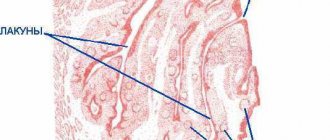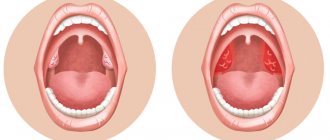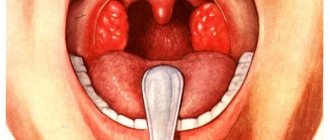General information
The problem of mycotic diseases in general, including fungal diseases of the throat (pharynx and larynx), becomes important due to the wide distribution and severity of the disease. The risk of dissemination of the process and even the development of fungal sepsis increases. Thus, over the past 10 years, the incidence of candidal pharyngitis ( pharyngomycosis ), laryngeal mycoses ( laryngomycosis ) and candidal tonsillitis have increased sharply - they account for 30 to 45% in the structure of all infectious lesions of the tonsils and pharynx.
Below you can see what a fungus in the throat looks like (photo). The growth of fungal infections of the throat is facilitated by massive antibiotic therapy, taking immunosuppressive and glucocorticoid drugs over a long period of time.
These and a number of other factors create favorable conditions for the development and spread of deep mycoses caused by opportunistic fungal flora, which is widespread in the external environment, can saprophyte the mucous membrane of the throat and was previously considered non-pathogenic.
Pharyngomycosis / laryngomycosis is not a highly contagious disease. In the vast majority of cases, inflammation of the mucous membranes of the throat caused by fungi of the genus Candida is secondary, developing against the background of predisposing factors. Fungal diseases of the throat are easily chronic (especially in cases of unreasonable/inadequate/adequate, but not aggressive enough therapy) and are prone to frequent recurrence. In most cases, they become stubbornly persistent and therapeutically resistant, and in cases of absence/incorrect treatment can lead to severe complications. The symptoms and treatment of fungal diseases of the throat are practically the same when the throat is affected by one or another type of fungus.
Symptoms
A fungal infection is characterized by the appearance of spots and spots with ulcers and blisters in the throat. Inflammation is accompanied by swelling of the larynx.
Related article:
Causes and symptoms of foot fungus. Treatment at home
| Form of infection | Pathogen | External features |
| Candidiasis | fungi of the genus Candida albicans | A rash appears on the larynx in the form of whitish dots and spots. The plaque has a cheesy consistency. The film is easily scraped off. After plaque removal, ulcers appear with signs of bleeding. |
| Actinomycosis | fungi of the genus Actinomyces | Lumps in the throat mixed with blood (infiltrates) are dark red in color. |
| Leptotrichosis (pharyngochosis) | bacteria Leptothrix buccalis Leptotrichia | Bacteria multiply under the influence of candidiasis and actinomycosis. When examining the throat, dense gray or yellow nodules in the shape of spikes are found. The plaque resembles foci of diphtheria. Unlike candidiasis, plaque does not come off. |
Laryngeal infections caused by fungus also have common symptoms.:
- General weakness.
- Pain while swallowing.
- Poor appetite.
- Burning, dry throat.
- Sensation of a foreign body when swallowing.
- Increase in body temperature from 37 to 38 degrees.
- Redness of the throat, palatine ridges.
- Swelling of the nasopharynx and tonsils.
- Soreness and enlargement of the lymph nodes in the neck.
Fungus in the mouth (pharyngomycosis): photo
Pathogenesis
The pathogenetic mechanisms of fungal infection of the pharynx are based on a restructuring of the body’s immune reactivity (accumulation in the blood and circulation of fungal antibodies), which causes immediate/delayed reactions. The development of throat lesions by fungi is also facilitated by changes in cellular immunity . In the pathogenesis of pharyngomycosis, an important link is specific/nonspecific sensitization of the body and allergy . The factor of traumatization of the mucous membrane of the oropharynx, which contributes to the development of the fungal process, also plays an important role. Tissue reactions are manifested by the formation of granulomas, atypical hyperplasia of the epithelium, necrotic changes of varying severity. Fungal elements in the tissues of the mucous membrane of the throat and the stroma of the tonsils are located predominantly subepithelial. Most often, mycotic foci in the pharynx are localized on the palatine tonsils, posterior wall, arches, velum and tongue.
Causes
The main causative agents of fungal infections of the oropharynx are fungi of the genus Candida (97%) and molds of the genus Aspergillus (in 3% of cases). Among the fungi of the genus Candida, the yeast-like Candida albicans (39%), C. tropicalis (12%), and C. krusei (9%) were most often isolated in patients. Almost all of these types of listed fungi belong to saprophytes (opportunistic microflora), which are activated when the body’s reactivity decreases and acquire pathogenic properties.
The leading reasons for the decrease in the body's resistance are immunodeficiency states caused by frequent and long-term administration of immunosuppressive/glucocorticoid drugs and massive antibacterial therapy. The development of pharyngomycosis is promoted by systemic diseases of the gastrointestinal tract and blood, diabetes mellitus , bronchial asthma and especially often intestinal dysbiosis , in which the lack of bifidobacteria leads to a decrease in the synthesis of B vitamins and, as a result, the unhindered and rapid colonization of fungal flora not only in the intestines, but also in all other cavities organisms in contact with the external environment (oral cavity, nose).
Occupational hazards include constant contact with gases, dust, and elevated temperatures. Often, due to diagnostic errors and inadequate treatment, an acute mycotic process in the throat becomes chronic.
Why is the formation of fungus in the maxillary sinus dangerous?
How can the growth of a fungal colony be dangerous? In any case, it’s not very pleasant when some kind of parasite, mold, or fungus lives in you. This is really a parasite that lives in the cavity of the maxillary sinus and feels great there. In addition, mycetoma is dangerous because the blood supply and oxygen supply to the brain deteriorates, since the function of nasal breathing is disrupted. A person simply begins to experience partial oxygen starvation due to mycetoma.
Plus, the waste products of the fungus in the maxillary sinus flow into the nasopharynx, which can additionally lead to additional complications, including the development of allergies and provoking respiratory diseases. And, of course, chronic sinusitis.
The role of CT in the study of mycetoma
Of course, a good computed tomogram gives a complete picture of the maxillary sinuses and is the main tool in diagnosing “mycetoma” when examining a patient. A CT scan of the maxillary sinus shows the location, size, and volume of mycetoma damage (local volume or total fungal infection of the cavity).
In fact, computed tomography is the gold standard for diagnosing mycetoma today.
Symptoms of fungus in the throat
Symptoms of fungal diseases of the throat (pharyngomycosis) are variable and are determined primarily by the general/antimycotic activity of the body, and then by the type of fungus that caused the disease. The clinical manifestations of candidiasis , aspergillosis and penicilliosis are practically the same. The acute form of the disease is characterized by a rise in temperature to a subfebrile level, a feeling of dryness/scratching and pain in the throat, hyperemia of the oropharyngeal mucosa, the appearance of necrosis of the epithelium, first white small and then extensive plaques that arise under the influence of a fungal infection, which persists when treated with conservative traditional methods .
Upon examination, multiple, difficult to remove, grayish-white plaques of irregular shape are detected on the mucous membrane, which are located on the palate, tonsils, arches and other places. After their removal, as a rule, erosion remains on the mucous membrane.
In the chronic form, patients' complaints appear cyclically every 2-3 weeks, that is, with frequent alternation of new exacerbations and unstable remissions, depending on the current immune status and other determining factors.
In cases of superficial damage, unexpressed hyperemia of the mucous membrane is determined with areas of translucent/dense deposits of a grayish-white color, having a predominantly lumpy, curd-like character, which are easily removed, exposing the hyperemic smooth mucous membrane. Less often, plaques become denser and merge, and when they are removed, the mucous membrane that bleeds with any damage is exposed (like diphtheria).
With the ulcerative-membranous variant of the lesion, localization of the pathological process is characteristic of the tuberous infiltrated tonsils and adjacent formations. At the same time, the ulcers are covered with an easily removable white coating. The submandibular and submandibular regional lymph nodes are in most cases slightly enlarged and slightly painful. Often lesions are found in other parts of the digestive/respiratory tract ( candidiasis , cheilitis , glossitis ).
Routes of infection
Infectious agents are opportunistic microorganisms. This means that they live in small quantities on the mucous membranes of a healthy person. However, they do not cause any changes or disrupt functions. The harmful effect is pathogenicity, manifested in changes in the bacterial balance.
In a healthy person, microorganisms do not manifest themselves in any way. As soon as the body's resistance decreases, the fungi actively grow and reproduce.
Some types of pathogens are transmitted from person to person through household means.
Routes of infection:
- Food;
- hygiene products;
- contact with the patient's saliva;
- medical instruments;
- from mother to fetus during childbirth.
In the carrier, the infection may not manifest itself in any way if the immune system is good. At the same time, there is a risk of infection from it to people with weak protective reactions.
Tests and diagnostics
The diagnosis of mycotic lesions of the oropharynx is based on complaints, examination of the patient’s oral cavity and laboratory data. If upon examination there are changes in the mucous membrane and a curdled white coating is detected, then a diagnosis can be made at this stage. If the picture of the pharynx (with an erosive-ulcerative/catarrhal process) is not specific, then additional studies are prescribed:
- Microscopy of the native preparation (examination of plaque under a microscope in a smear from the oropharynx allows you to quickly visualize fungal cells, spores, pseudomycelium).
- Bacteriological method (inoculation of the contents of the mask on a nutrient medium). Allows you to identify a specific type of fungus and determine its sensitivity to antifungal drugs.
- Immunological examination (detection of pathogen antigens in the blood).
Treatment of fungus in the mouth
Fungal disease is treated comprehensively, using several means.
Goals of therapy :
- eliminate the cause of the infection;
- restore the microflora of the oral mucosa;
- strengthen the immune system.
How is fungal sore throat treated? In mild cases, you can get by with an ointment that is applied to the affected areas.
- Amphotericin . The product has pronounced antifungal properties. Amphotericin blocks most strains (pathogens).
- Clotrimazole is an antifungal (fungicidal) medicine. The active substance penetrates the body of the fungus and inhibits its growth. The drug may cause side effects - itching and red spots on the larynx.
Antiseptic solutions are used to treat the mucous membrane. The drug is changed once a week. The back wall of the larynx is treated with solutions and the tonsils are washed.
Related article:
Irunin - Treatment of nail fungus.
Reviews, price, analogues, instructions and price Common antiseptics :
- Miramistin;
- Chlorhexidine;
- Lugol's solution.
In a hospital setting, laboratory irrigation of the larynx is carried out - endolaryngeal administration of drugs and physiotherapeutic procedures.
How to treat a mild form of laryngeal fungus in an adult?
For a lasting effect, use repeated rinsing of the mouth with alkaline solutions.:
- 25% baking soda solution;
- Iodinol;
- 20% solution of Borax in glycerin.
Moderate fungal tonsillitis is treated with antifungal ointments:
- levorin;
- nystatin;
- dekaminovaya.
The course of therapy is 10 days. Treatment is carried out 3-4 times a day.
To treat advanced forms of infection, take fungal tablets.
The drugs are prescribed in the acute stages of the disease. Popular drugs in tablet form :
- Nystatin;
- Levorin;
- Decamine;
- Fluconazole.
The course of treatment is 1-2 weeks. After eliminating visible lesions in the throat, tablets are taken for prevention, reducing the dose. For children under 12 years of age, tablets are contraindicated.
An advanced fungus is difficult to remove, therefore, along with antifungal drugs, general tonics are taken:
- vitamin complexes;
- probiotics;
- immunomodulatory drugs – Immunal, Polyoxidonium, Ginseng extract.
If pharyngomycosis is complicated by other types of infection, antibiotics are prescribed.
Fungus in a child's throat
The incidence of FM in childhood is significantly higher. Candidiasis of the mucous membrane of the mouth and throat is especially common in newborns (thrush) and in children under 1 year of age. This is due to the incomplete formation of the child’s immune system from exposure to a mycotic infection. Pharyngomycosis also often affects older children, in whom the onset of the disease is caused by fungal infection at an early age and the lack of complete elimination of the source of infection in the oropharynx. Treatment of fungus in the throat in a child is identical to the treatment of adults, taking into account the age-specific dosage of drugs. It is also necessary to take into account the complexity of local treatment in children.
Features of pharyngomycosis
Pharyngomycosis affects both adults and children. Only in childhood the disease is more common in the form of thrush.
In adults, throat fungus can be combined with other infections.:
- glossitis - inflammation of the tongue;
- gingivitis – inflammation of the gums;
- cheilitis - inflammation of the lip;
- stomatitis – ulcerative lesions of the oral cavity.
Men get fungal infections more often than women.
Throat fungi are a type of mycosis (the general name for infections caused by parasitic fungi). Candida lives in small quantities in different parts of the body in every person. Under unfavorable conditions, fungi of this genus begin to actively multiply, which causes inflammation.
Such conditions arise in the following cases:
- decreased protective functions of the body;
- chronic diseases of the ears, nose and throat;
- autoimmune diseases - pathologies in which the destruction of organs and tissues occurs as a result of disturbances in the immune system, which produces antibodies against its own cells;
- immunodeficiency.
Sore throat caused by a fungus can occur in 3 forms:
- candidiasis (fungal sore throat);
- actinomycosis - the causative agent of infection lives on the mucous membranes;
- leptotrichosis is a saprophytic fungus, infection occurs through soil and dust.
Fungi of the genus Candida provoke pharyngomycosis in 93% of cases. Other infections are associated with mold microorganisms, pathogens of actinomycosis and leptotrichosis. Most often, the fungus is activated when the body's resistance weakens.
Mushrooms of the genus Candida
Immune system disorders cause increased levels of microorganisms in the mouth. Dysbacteriosis develops. Under the influence of external and internal factors, active growth of candida begins, which causes candidiasis - fungal sore throat.
Pathogens live everywhere:
- in the human body;
- in public places;
- in a humid environment.
Related article:
Nitrofungin for nail fungus: reviews, composition, instructions for use
Prevention
Prevention of pharyngomycosis is aimed at increasing immunity and involves the rational and justified use of antibiotics and glucocorticoid drugs. The duration of antibiotic therapy should not exceed the period sufficient to eradicate the pathogen. Antibiotics should not be prescribed for prophylactic purposes, especially for viral respiratory infections. If repeated courses of antibiotic therapy are indicated, mandatory antifungal therapy is required.
Adequate treatment of endocrine pathology ( thyroiditis , diabetes , obesity ) is necessary. Hardening, good nutrition, healthy lifestyle.
Features of treatment in children
The disease has entered the acute stage if the child develops a white coating on the tonsils in the form of grains or plaque.
Fungus on the tonsils is common in children. For successful treatment, follow a diet. Products excluded from the diet :
- sweets;
- baked goods;
- salted, pickled vegetables.
You should limit your consumption of fermented milk products. An important step on the path to recovery is careful hygiene. Dishes and nipples are sterilized after use.
For thrush, the child’s tonsils and throat are wiped with solutions:
- with soda;
- infusion of oak bark;
- Miramistin.
Among the medications, drops in the mouth based on Clotrimazole are prescribed. For example, Pimafucin. Treatment is complex and includes local and restorative medications.
For thrush, children are prescribed:
- antihistamine drops;
- immune stimulants;
- beneficial bacteria;
- antifungal drops.
Fungal diseases indicate a weakening of protective reactions. Taking antifungal drugs is combined with strengthening the immune system. Only complex therapy will help avoid reactivation of the throat infection.
List of sources
- Kryukov A.I., Kunelskaya V.Ya., Shadrin G.B. Epidemiology of fungal diseases of the upper respiratory tract and ear. Problems of medical mycology. St. Petersburg, 2011. T. 13, No. 1. — P. 28-31.
- Sergeev A.Yu., Sergeev Yu.V. Fungal infections. Guide for doctors. 2nd ed. -M.: BINOM Publishing House, 2008. - 408 p.
- Kunelskaya N.L., Izotova G.N., Kunelskaya V.Ya., Shadrin G.B., Krasnikova D.I., Andreenkova O.A. Pharyngomycosis. Diagnosis, prevention and treatment. Medical advice. 2013. No. 2. P. 42-45/
- Kunelskaya V.Ya., Romanenko S.G., Shadrin G.B., Krasnikova D.I. Laryngomycosis. Modern approach to diagnosis and treatment. Materials of the XIV Scientific and Practical Conference “Pharmacological and physical methods of treatment in otorhinolaryngology”, Russian Otorhinolaryngology. 2021. 3(82). pp. 38-39.
- Kunelskaya V.Ya., Shadrin G.B., Krasnikova D.I., Andreenkova O.A. Rational methods of treating UDP candidiasis. Advances in medical mycology. 2013. 11. P.99-102.







